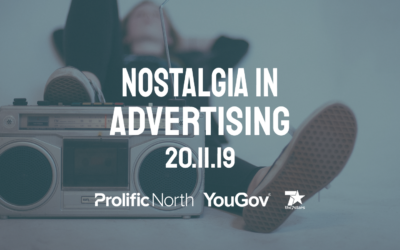In partnership with Prolific North, market research and data analytics firm YouGov held a webinar with media sector leaders to discuss the findings of a first of its kind report on media consumption.
The ‘International Media Consumption Report 2021’ draws on unique insights into how consumers around the world have consumed media in the face of the pandemic.
Jules Newby, Sector Head of Media at YouGov, Ewan Douglas, Head of Nations & Regions Sales at Channel 4, and Stuart Lunn, MD, Havas Media Manchester gathered virtually to discuss and review the results, and give their take on ‘the new normal’ media consumption landscape.
With a focus on streaming media, the panel discussed how the lockdown has affected media consumption, and what the future holds as restrictions are eased.
Podcast listening
Among YouGov’s findings, it was shown that podcast listening rose in the last year, dissuading fears that the commute was a major factor in listening hours.
YouGov’s data also shows that commercial radio listeners fell, while Spotify listening rose in Great Britain.
“We’ve stopped commuting, we’re working from home and we’re shopping from home and we’ve seen this have a big impact on our media consumption habits. There have obviously been some big winners and losers as a result of this change in behaviour,” explained Jules Newby, Sector Head of Media at YouGov.
Referencing one of his clients, Stuart Lunn, MD at Havas Media Manchester added: “If you looked at BBC Sounds last year there was exponential growth, particularly in Q2. We saw over 300 million listens just over that quarter, which was a massive spike compared to where we expected it to be.”
But a lack of commuting has had a negative effect on newspaper sales, explained Newby.
Print and publishing
Referencing readership figures which compare the US and Great Britain, YouGov’s data shows a downward trend in the popularity of print and digital magazines and newspapers in the US.
“The US in 2020 gave up on reading, with a decline in print and newspapers in digital and print format. In the UK we saw a big decline in print, a lot of that is driven by not commuting,” Newby said.
In Great Britain, 2020 saw a slight upward trend in digital newspapers where the US did not, YouGov’s research showed. Newby said this could be explained by an increase in app-based newspapers.
Lunn added that print media and particularly newspapers hadn’t lent themselves to the fast updates about coronavirus and that TV news and televised government briefing had made the medium a more attractive prospect than newspapers.
He added that there was fatigue caused by the rolling news around coronavirus on television, which might have made picking up a newspaper less attractive.
But, he said, “it’s very difficult to discount a particular channel based on what’s happened in lockdown.”
Ewan Douglas, Head of Nations & Regions Sales at Channel 4 added that it was unlikely that working and consumer behaviours would return to pre-2020 figures even after lockdown, and predictions about a future media landscape shouldn’t consider a return to normal, but where the ‘new normal’ may land.
“Print media has seen this coming for a long time, the Guardian has done a great job in turning their numbers around,” said Douglas.
“Papers are playing a different role in people’s lives,” he said, citing longer-form stories from trusted news outlets as an example of the medium’s unique offering.
Watched media and streaming
Where print may have seen a downturn in the last year, watched media has seen a lockdown boom, reports YouGov.
Newby explained “We’re seeing increases across the board, in live TV, catch-up, and streaming. The big growth has been in streaming, particularly the amount of people viewing but also the hours viewed.”
Newby said the lockdown has led to a net effect in which “a lot of impressions have dropped out of the marketplace, and a lot of choice of channel has dropped out of the marketplace. We’re left with TV and digital.”
YouGov’s research defined a section of the population as ‘super streamers’, those who regularly watch two or more streaming services and have a music streaming service.
YouGov’s data shows this section of the population tends to be 24-34-years-old, have no children or one child, and are wealthier than the average household.
With other forms of advertising not an option during the lockdown, Newby said it was important to consider how this group of ‘super streamers’, who are paying not to see or hear ads, might be targeted.
“Some people just don’t want to be marketed to in the way that we have traditionally done through performance,” said Lunn, and he suggested brands would need to embrace an audience’s move away from ad-supported content.
Douglas added that demand for television and demand for control over watching should be considered as distinct.
He reported that Channel 4s’ catch-up and streaming platform All4 had seen its viewing figures double in the first quarter of 2021. All episodes of its newest series were now being put on their platform first “to get ahead of that behaviour, because we know we need to speed up as we see changes in live viewing”.
On the threat posed by viewers opting for ad-free platforms such as Netlflix and Disney+, he said that streaming was good for the ecosystem and that several Channel 4’s productions were in fact co-productions with the likes of Netflix.
“There’s room for everyone,” he said, reporting that Channel 4’s ‘It’s A Sin’ drove All4 viewing up 100% in the first quarter of 2021, with 6 million viewers for each episode.
On the show, he said: “It’s a tragedy about the AIDS epidemic in the 1980s in the UK. Netflix is never going to make that show. It won’t resonate anywhere else. People will always want programmes about where they live.”
On the growth in streaming, Lunn said from his agency perspective “some people might see it as being a risk of sorts, but you should embrace it.
“It’s a good thing, it’s people telling you how they want you to engage with them.”
Lunn said that the value exchange has become clearer. What these ‘super streamers’ are telling their providers is “the value exchange doesn’t work for them. They are saying ‘I’m not getting enough back, and that’s the challenge for us and brands.”
“We have to make it so that they do get something back so that they don’t feel like they are getting blasted with things that aren’t relevant to them.
“The BBC is crying out to engage with a more youthful audience, and that’s a massive challenge for us, but we shouldn’t shy away from it. If you can do it, and find the right answer, you’re future-proofing your business”.
For Channel 4 and All4, Douglas said the exchange with its consumers was “we’ll give you an hour of great quality, engaging, entertaining content and we want you to watch a few ads in exchange for that.”
“For the vast majority of people, that’s fine”, he said, adding that All4’s newer subscription-based, ad-free model is “not that popular”.
Northern viewing
While the difference between the North’s viewing habits and the rest of Great Britain were relatively small according to YouGov’s figures, Douglas added that for Channel 4 there were geographically distinct spikes for certain programmes, citing Derry Girls as a show which has seen huge success in Ireland but has also been a hit elsewhere.
He said: “If you can map that out so that each region has their own voice, that is a real sweet-spot for broadcasters”
Lunn added that there were occasional outliers. Citing BBC data he said “we recently noticed that the numbers were particularly different for some reason in adoption and usage of iPlayer in the North East.”
On how to target regional viewers and group viewing during, Lunn said there were opportunities to target audiences, or ‘hyper-target’ despite the crack-down on tracking from tech providers such as Apple.
Douglas added: “While we see that shift into digital viewing, which is a great thing for us, we get first-party data on that. Everyone’s logged in and we have 28 million logged-in viewers.
He said that among its products, some are taking advertiser’s first-party data and Channel 4’s data, bunkering and anonymising it, and then using this data for targeting.
For one of their advertisers, Just Eat, Douglas said their approach was to target customers who might drop-off and message them.
“You’ve never been able to do that with a product before,” he said. “That’s straight into people’s living rooms”.
But on targeting viewers, Lunn cautioned that “there is still an issue, broadly, with trust in the industry.”
The ‘new normal’
On the potential media consumption habits to come post-lockdown, the panel agreed that it would be difficult to predict any specific bounce-backs or dips in interest.
“There is going to be a drop in consumption generally, but whether that means a seismic shift for particular platforms, I’m not sure it will,” said Douglas.
Lunn said as production ramps up and more content is created on streaming services, consumers may in fact double-down on their subscriptions rather than pulling back on their viewing habits.
He also said that the trends to come post-lockdown will be led by factors outside of the lockdown itself.
“Basic social learning says you’re a product of your environment, and if people are suddenly listening to podcasts maybe you listen to a podcast. If they suddenly revert to habit, maybe you do that as well.”
“We know there will be some change, but we don’t know what will land and will make a meaningful difference until we start to see it play out.
“My message, if you’re a brand in particular, is just about agility.”
Douglas added: “The desire for people to watch great quality TV entertainment is bigger than ever, and that’s borne out in numbers.
“We love telly, and living in the UK we’ve never had a better choice and more high-quality things to look at, and that drives the whole industry forward”.
“I think the marketers of this country have served their organisations brilliantly well across this period with a restricted choice of what they can do.”
“As we open up, we’re going to see a lot of good stuff coming through.”











